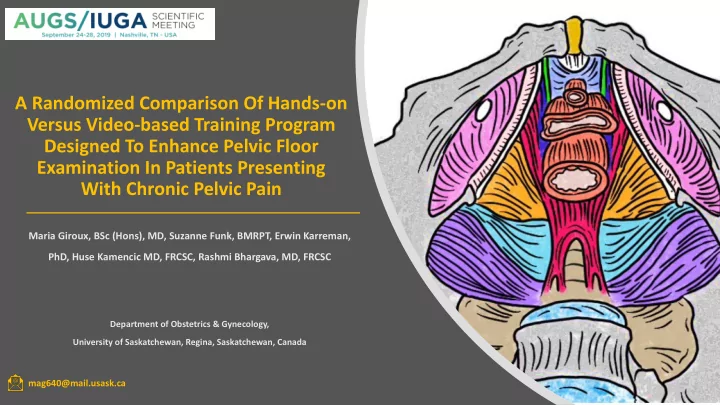

A Randomized Comparison Of Hands-on Versus Video-based Training Program Designed To Enhance Pelvic Floor Examination In Patients Presenting With Chronic Pelvic Pain Maria Giroux, BSc (Hons), MD, Suzanne Funk, BMRPT, Erwin Karreman, PhD, Huse Kamencic MD, FRCSC, Rashmi Bhargava, MD, FRCSC Department of Obstetrics & Gynecology, University of Saskatchewan, Regina, Saskatchewan, Canada mag640@mail.usask.ca
Speaker Disclosure Nothing to disclose 2
Persistent pain for ≥6 months Chronic Pelvic Pain 15-20% of women 3
Patients with chronic pelvic pain who were Pelvic Floor also found to have pelvic floor myalgia: Myalgia 63% 73% Examined by a Examined by a physician physiotherapist Fitzgerald et al., 2011 4
Persistent symptoms Central sensitization Untreated Unnecessary laparoscopic surgery Symptoms Psychological distress Impaired quality of life 5
Assessment of the Pelvic Floor Musculature 6
Objectives: A randomized, single-blinded, 1. Compare the effectiveness of hands-on vs video- single-center trial based training of a comprehensive assessment of the pelvic floor musculature on a pelvic model January 1 - November 18, 2018 2. Design an effective training program to enhance examination of the pelvic floor musculature for patients presenting with chronic pelvic pain 7 This Quality Improvement study was reviewed and exempted from the Saskatchewan Health Authority and University of Saskatchewan Research Ethics Boards.
Study Population Assessed for eligibility 1. Obstetricians and Gynecologists (n=46) 2. Obstetrics and Gynecology resident physicians 3. Family Medicine physicians 4. Family Medicine resident physicians 5. Medical students (years 2-4) Randomized Excluded (n=0) (n=46) Inclusion criteria: 1. Age ≥18yo 2. Learners affiliated with College of Medicine at the University of Saskatchewan in Regina campus. This includes obstetrics and gynecology resident physicians (Years 1-5), family medicine resident physicians (Years 1-2), and medical students (Years 2-4). Video group Hands-on group 3. Obstetrics and Gynecology staff affiliated with the University of (n= 23) (n=23) Saskatchewan in Regina campus. Exclusion criteria: 1. Physical limitation that prevents a participant from performing a pelvic examination Dropped out (n=0) Dropped out (n=0) Completed training Completed training and assessments and assessments (n=23) (n=23) 8 Figure 1: Participant Enrollment Flow Figure
Didactic Lecture Video Figure 2: Structure Of The Training Session Hands-on 9
Primary Outcome Measure: 1. Change in written examination and OSCE scores from pre-training to post-training assessments in the video and hands-on groups Outcome Measures Secondary Outcome Measures: 1. Change in the level of comfort with performing pelvic floor examination in patients presenting with chronic pelvic pain before and after the training program 2. Usefulness of the training program for clinical practice
Data Analysis Categorical variables Continuous variables Sample size required: Chi-square test Mixed design ANOVA • 21 participants per training group • Using the minimally important difference in OSCE and written examination scores of 15%, a standard deviation of 5, alpha level of 0.05, and power of 0.80 11
Results 24.8 25 Mean Written Assessment Scores 24.3 20 15.6 Written 15 Assessment 13.3 Scores 10 5 PRE-TRAINING POST-TRAINING Hands-on Video Figure 3: Mean written assessment scores before and after training in video and hands-on groups (maximum score was 30). There was no statistically significant difference between the 2 groups 12 (p=0.19).
Results 30 26.5 25 24.4 Mean OSCE Scores 20 OSCE 15 14.3 Scores 11.7 10 5 PRE-TRAINING POST-TRAINING Hands-on Video Figure 4: Mean OSCE scores before and after training in video and hands-on groups (maximum score was 30). There was no statistically significant difference between the 2 groups (p=0.10). 13
Usefulness for Clinical Practice Participants found the training program to be useful for their clinical practice 14
Both hands-on and video-based training methods are Conclusion effective. There is no difference in the degree of improvement in assessment scores between both methods. 15
New effective multidisciplinary training program for teaching the assessment of the pelvic floor Significance musculature to identify a possible muscular cause or contribution to chronic pelvic pain and provide early referral for appropriate treatment. 16
Video IUGA Academy OBGYN Academy https://obgynacademy.com SEARCH https://academy.iuga.org SEARCH
18 Hands-on Chronic Pelvic Pain & Pelvic Floor Myalgia Workshop https://obgynacademy.com/ chronic-pelvic-pain/ 18
19 Both versions Guide to Assessment of the Pelvic Floor Musculature https://obgynacademy.com/ chronic-pelvic-pain/ 19
20 Workshop at both national and international levels in order to improve patient care through Future provider education Direction 20
References Adams K, Gregory WT, Osmundsen B, Clark A. Levator myalgia: why bother? Int Urogynecol J. 2013 Oct;24(10):1687-93. Bo K, Frawley HC, Haylen BT, Abramov Y, Almeida FG, Berghmans B, et al. An International Urogynecological Association (IUGA)/International Continence Society (ICS) joint report on the terminology for the conservative and nonpharmacological management of female pelvic floor dysfunction. Int Urogynecol J. 2017 Feb;28(2):191-213. Fitzgerald CM, Neville CE, Mallinson T, Badillo SA, Hynes CK, Tu FF. Pelvic floor muscle examination in female chronic pelvic pain. J Reprod Med. 2011 Mar-Apr;56(3-4):117-22. Hilal Z, Kumpernatz A, Rezniczek GA, Cetin C, Tempfer-Bentz EK, Tempfer C. A randomized comparison of video demonstration versus hands-on training of medical students for vacuum delivery using Objective Structured Assessment of Teaching Skills (OSATS). Medicine. 2017 Mar;96(11):e6355. Kavvadias T, Baessler K, Schuessler B. Pelvic pain in urogynecology. Part 1: evaluation, definitions and diagnosis Tu FF, As-Sanie S, Steege JF. Prevalence of pelvic musculoskeletal disorders in a female chronic pelvic pain clinic. J Reprod Med. 2006;51(3):185-9. 21
Recommend
More recommend